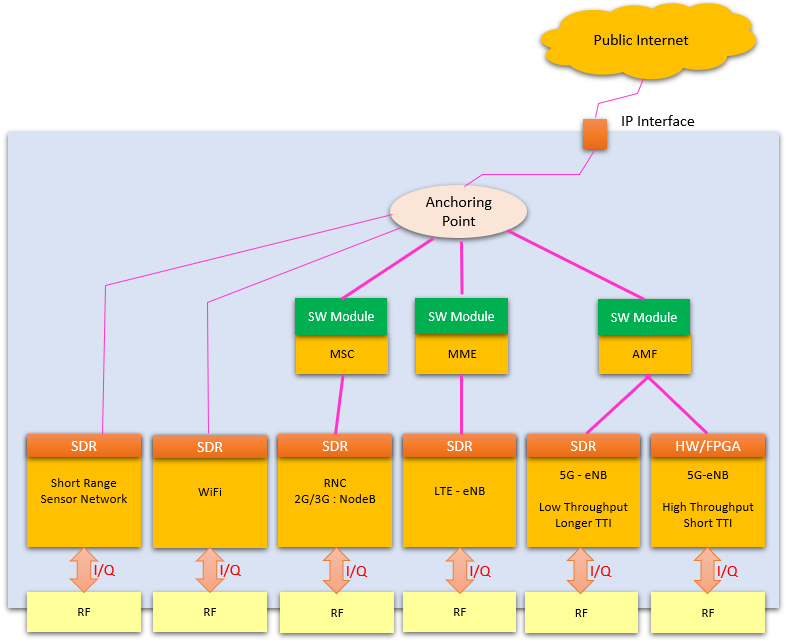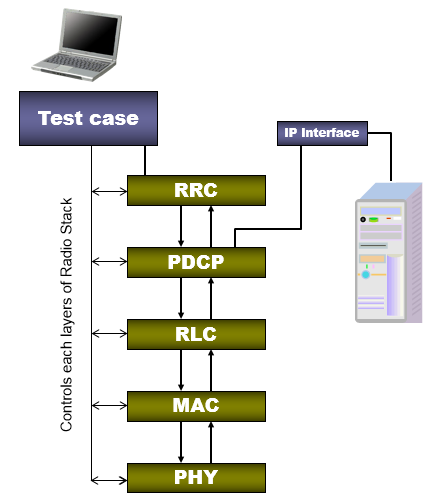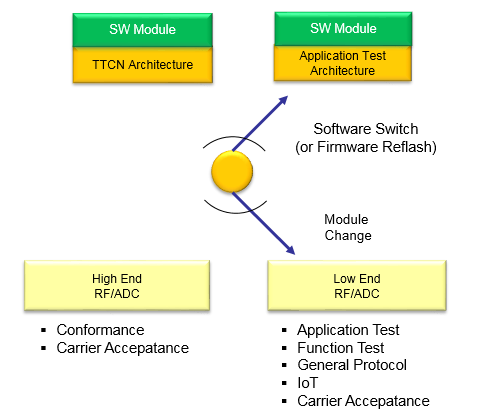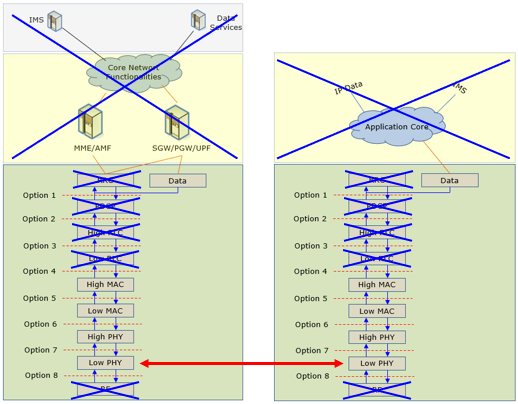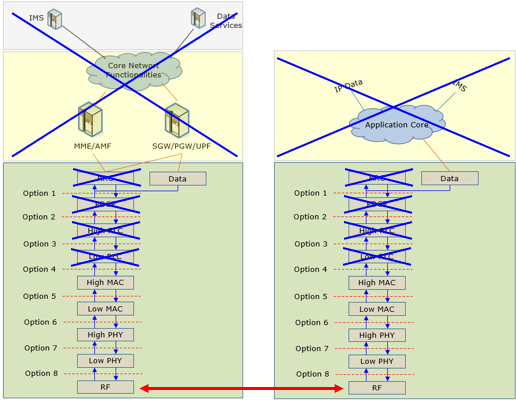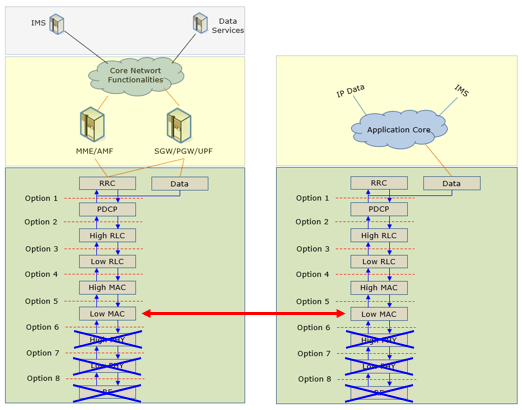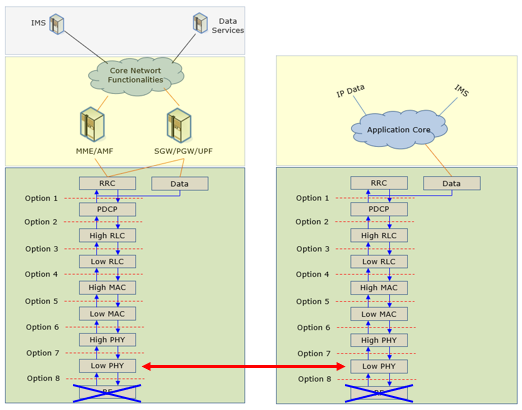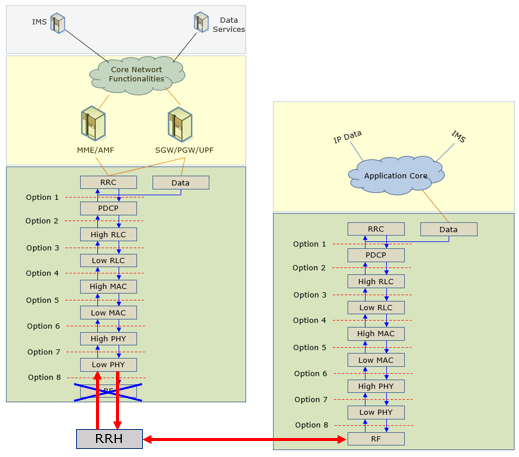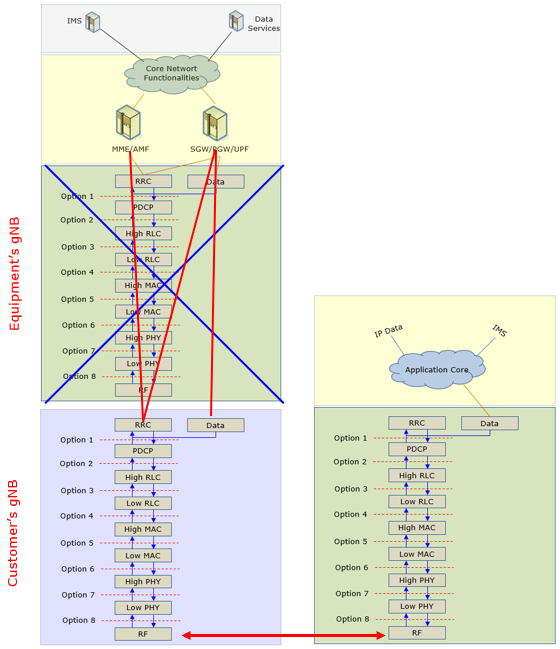|
|
||
|
In this post, I will talk about a kind of ideal test equipment (my dream) for 5G device. Actually this is not only for 5G and it can be any cellular technology, but I talk of this mostly under the context of 5G because 4G test equipment market is already almost saturated and I don't think there would be drasitic redesign activities. Followings are some of the topics (aspects)which I want to touch on.
Requirement (Getting Tougher)As 5G requirements for Network and UE gets tougher, it can easily be anticipated that the requirement for the device test equipment will get tougher as well. Followings are some of the features that will be strongly required for 5G.
Is this new requirement ? Haven't we been under pressure with all of these all the time ? Yes, it is true. But the amount of pressure will be enourmous. The scope of cost and flexibility would be something beyond what we can imangine now. Every equipment vendor have high expectation of IoT being an important part of 5G, but it doesn't seem that they take any serious consideration of the nature of IoT market. There will be incomparable number of IoT device manufacturer comparing to the current mobile phone manufacturer which is good news for the equipment vendor. However, the size and budget of IoT device manufacturer will be incomparably small comparing to the current mobile phone vendor or chipset vendor. They should not expect to see multi-million or at least sub million dollar equipment to all of IoT device makers. Therefore, it is about time for equipment vendors to come out with brilliant/disruptive idea to reduce the cost of the equipment and still providing all the features required for testing. One thing that was not requested before but might be a strong requirement would be 'Portability' (Compact and Easy to carry around). We will see more and more devices embedded in a vehicle or a lot of IoT devices installed in remote place. At the phase of initial test before those devices gets installed in final place, we can test it at the bench as we usually do with mobile phone for now, but how about test/verification or troubleshoot after the installation ? I think it would be much easier to bring the equipment to the installation place rather than uninstall/disassmble the installed device just to test it on the desk. Conceptual Architecture of UE Test EquipmentEven though we will call it 5G device (or whatever 3GPP will name it), it will be required for the device to support all or most of the existing (legacy) technology. As a result, the test requirement will also be required to support all the legacy technology. My personal 10000 feet overview of the equipment architecture is as follows... this is a kind of my dream equipment -:).
Followings are some of the key features of this imaginary test equipment :
Where Are We now ?I have wrote the first version of this idea (Figure 1) in Jan 2015 and I want to summarize the brief status of test equipment here.
As of Oct 2021, I still don't see my dream equipment as described above from any of the vendors that I know of, but I see great progresses especially in SDR area. Followings are some of the bullets that I want to point out.
How about Conformance Test ?Even though the architecture illustrated above would be my dream equipment, I think I should admit that it can cover all of the test scenario we need to go through. One important area is Conformance Test. Even though the above architecture would be ideal for application layer test or reproducing real life problem (live network problem), it would be tricky to perform the conformance test cases. Most of the conformance test cases has a couple of characteristics as listed below.
Due to these factors, most of the test equipment being used for Conformance (especially for protocol conformance) is based on following architecture. As you see here, there is no NAS/Core Network components. Each of the radio stack is directly controlled by the test case and NAS/Core Network part is simulated by radio message directly created by the test cases.
Modular Architecture for Both Software and HardwareI hope to see all of this within a common frame (there might be some exceptions for IoT though. We may think of portable hardware frame for IoT. The equipment vendor may go with different hardware frame to meet the price and portability requirement in IoT industry, but it would be better to use the same software even with such a low cost / small sized equipment). You may say 'I understand we may need two different software module, but why do we need two different Hardware module and bother to replace it depending on use model ?'. It is purely because of the cost. For users, it would be the best to use a single / best performing hardware to cover everything and there is no technical restriction for this. Development / Manufacturing cost for different hardware is a harsh reality. We cannot get everything in single penny.
Modularization of the protocol stack and functionalityWhat I described in the section Conceptual Architecture of UE Test Equipment is basically about what kind of radio access technology to support in the equipment. What I want to talk about in this section is how to support each of the radio technology (especially on cellular communication technology) in terms of protocol stack all the way from the RF through the application service beyond the core network. The architecture of protocol stack in my dream equipment is as follows ([Figure 4]). I highlighted the structure in three segments. Segment 1 represents radio protocol stack and this structure is directly quoted from TR 38.801-11.1.1. Segment 2 represents the core network. Ideally it would be the best if all of the network components is structured as per 3GPP core network architecture, but it may be too much to implement all those components and interfaces seprately in a single box test equipment. However, I want at least a few key components of the core network and interfaces implemented as separate entity as per 3GPP sepecification as shown in Segment 2 (Note, the orange lines shown at the top of segment 1 and in segment 2 represents the interfaces that complies to 3GPP standards).
There are some cases where UE modem manufacturer wants to test their protocol stack before their PHY layer is ready or in parallel with the PHY development. If a test equipment support a split and provide a standard interface as shown below, UE modem maker can perform the test only at MAC and above. As of Now (Nov 2021) and as far as I know of, there are some equipment vendor to provide this type of solution with their own proprietary interface. I don't see any SDR solutions to support the split at this level.
In this test setup, we can test DUT(UE) even when it's RF is not implemented yet. By Nature, all the SDR based test equipment should be able to support this kind of test. And as far as I know of, some major test equipment vendor supports this kind of test mode. The data traffic between the test equipment and DUT is digital IQ data. As of Oct 2021, the major issue with this kind of testing is that there is no industry standard (like 3GPP) for the interface for the connection point(Option 8 shown below). Every equipment supports their own proprietary interface. There should be some agreement between test equipment vendor and UE modem manufacturer on the physical/electrical specification of the connection point.
Most of the test equipment is designed for this kind of test and actually for this kind of test we may not need to modularize the equipment. In this test, it is assumed that DUT (UE) is ready with full stack from RF through application layer and it can be connected to the test equipment via Over The Air or RF cable.
Another type of test feature I am personally interested in is to support the split between eNB/gNB and Core Network and provide standard interface between them so that we can replace the equipement core network with end user's core network (like live network core network). As of now (Nov 2021), most of SDR based solutions (Amarisoft, OpenAirInterface, srsRAN etc) would support this type of modularization and interface, but probably Amarisoft solution would be the most extensively tested / verified solution as far as I know of.
Connectivity vs TestingWhen do we need a Cellular network simulator ? As a person who are playing with various kind of cellular network simulator as part of job and as a hobby, I have roughly two cases (two types of motivation) that make me want to have this kind of network simulator. One is just to have 'Connectivity' and the other one is to have 'Testing Capability'.
i) [As of Jan 2016] Maximum throughput for latest category and Carrier aggregation with more than 3 CC (e.g, 600 Mbps and higher throughput) ==> This requirement got even higher as of now (Oct 2021), common max requirement on LTE would be 5 CCs with more than 20 layers (over 2 Gbps) and 8 CCs with more than 16 layers (over 7 Gbps). ii) Multiple Radio Access technology in one box (e.g, Not only LTE but also other legacy technology like 2G/3G) iii) Various Negative Test/Corner Case test capability iv) Real time logging and analysis along with high throughput v) RF accuracy even at very low Cell Power (meaning maintaining good SNR even at low cell power) In user's perspective, of course we want to both types of equipment. However, reality would not go as we hope. Major issues are 'cost' and 'mind set'. As I mentioned above, you get the equipment with a relatively low cost if you only need a simple connectivity (cellular data pipe), but you would need to consider huge investment if you want to have detailed testing and analysis/troubleshoot capability. It is mainly because it requires high-end hardware design and a lot of cost to develop, maintain and support those testing capability. Usually there are only several equipment vendors who can afford to such a big investment and it doesn't seem to be that those mainstream equipment vendor wants to release low cost equipment. However, I think time will come when the mainstream equipment vendor should look look into low cost /more accessible equipment because the SDR based/low cost solution provided by some company or open source organization is rapidly expending their capability and they will see more and more pressures directly from end users as well.
|
||
